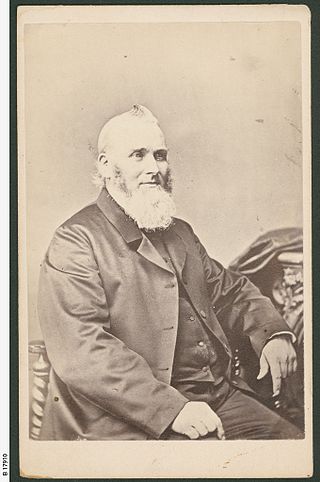The Churches of Christ in Australia is a Reformed Restorationist denomination. It is affiliated with the Disciples Ecumenical Consultative Council and the World Communion of Reformed Churches.

Sir Samuel James Way, 1st Baronet, was an English-Australian jurist who served as Chief Justice of the Supreme Court of South Australia from 18 March 1876 until 8 January 1916.

Sir John Hannah Gordon KC was a Scottish-Australian politician and judge. He was a member of the South Australian Legislative Council from 1888 to 1892 and from 1893 to 1903. He was a minister under four Premiers: John Cockburn, Frederick Holder, Charles Kingston and John Jenkins, variously as Minister for Education, Chief Secretary, Attorney-General, and Minister Controlling the Northern Territory. He was a judge of the Supreme Court of South Australia from 1903.

John Campbell was a Scottish Congregationalist minister at the Moorfields Tabernacle in London. He was the second successor there of George Whitefield, the Calvinistic Methodist. He founded and edited religious magazines and journals, including the Christian Witness and the British Banner.

Moritz Richard Schomburgk, generally known as Richard Schomburgk, was a German botanist and curator of the Adelaide Botanic Garden.
Rev. Ridgway William Newland, frequently spelled "Ridgeway", was an English Congregationalist minister who with his large family emigrated to the young colony of South Australia, where he had a considerable influence in the Encounter Bay district. Many of his descendants were important in the history of the State. He has been called "The father of the South".
George Alfred John Webb was an English painter who had a considerable career in Australia painting portraits of South Australian and Victorian public figures. In correspondence, he signed his name "George A. J. Webb"; many of his paintings, but not all, were signed simply "WEBB".
Allan Campbell was a South Australian politician, medical practitioner and philanthropist.

Dr. Edward Willis Way, frequently written as "E. Willis Way", was a noted medical doctor and surgeon in the early days of the colony of South Australia.

Serena Lake was an English Australian suffragist, temperance activist, and evangelical preacher in South Australia.

Cadwallader William Evan, generally referred to as Rev. C. W. Evan, was a Congregationalist minister in colonial South Australia, the first to serve at the Stow Memorial Church, Flinders Street, Adelaide.

William George Torr MA, BCL, LLD, often referred to as "Old Oxford", was a religious educator in South Australia.

Rev. James Maughan was a Methodist minister in Adelaide, South Australia. His name was commemorated in the Maughan Church, Franklin Street, which has since been demolished.
Joseph Robertson MA was an Australian Congregationalist minister.

John Gardner was a Scots-born Presbyterian minister in Adelaide, South Australia, the first incumbent of Chalmers Free Church of Scotland, now Scots Church, North Terrace, Adelaide. He later served at Launceston, Tasmania and Queenscliff, Victoria.
James Henderson was a Scots-born Presbyterian minister in Victoria and South Australia who was twice removed from his church after allegations of misconduct.
George Stonehouse was a Baptist minister in South Australia, founder of the LeFevre Terrace Baptist Church, North Adelaide, and first president of Adelaide Theological College.
James Lyall was a Presbyterian minister in the early days of Adelaide, South Australia.
John Crawford Woods, generally referred to as J. Crawford Woods, was the first minister of the Adelaide Unitarian Christian Church, South Australia, serving from 1855 to 1889.
Henry Hussey was a pastor in the colonial days of South Australia, closely associated with the Christian Church on Bentham Street along with pastors Abbott, Finlayson and Playford. He was the author of several influential books on religious themes, and a memoir.










